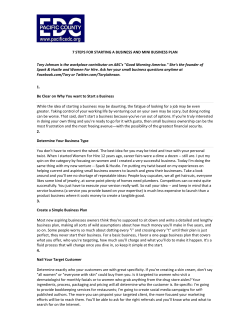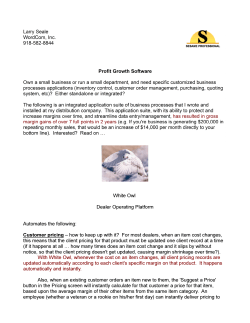
Athletic Footwear Industry Rob Pannell,Kyle Ewanouski, Vaibhav Gupta, Venkat Koduru 1
Athletic Footwear Industry Rob Pannell,Kyle Ewanouski, Vaibhav Gupta, Venkat Koduru 1 Why athletic footwear? • Constant observable shift in consumer preferences due to seasonality • Relevant to college students since most as consumers of athletic shoes and involved in sports team • High (45%) gross margin; strong focus on marketing • Nearly all inputs are outsourced except for endretailing • Push to cut out retailers, and sell directly to consumer 2 Industry Structure 3 Quick Figures Global Footwear Market $185 billion Global Athletic Footware Market $75 billion US Athletic Footware $14 billion • US Athletic Footwear represents roughly 19% of global athletic footwear market • Asia-Pacific market is expected Avg Gross Margin: Avg Net Margin: 45% 7% Avg Marketing Expense: 10% 4 Shoe Distribution Shoe Manufactures Retailers Customers 5 Types of Shoes • Based on survey data by NPD group of purpose of athletic footwear • Nearly 50% of sales is for “Casual Athletic” and “Running” 6 Customers • 50% of sales in the US are to men, 30% to women, and 20% to children/infants • Males account for roughly 60% of sales to children and infants, so trend is not reversing 7 Let’s look closer • Though Men bought the same number of athletic shoes, they purchased more expensive ones • Women too purchased more expensive shoes, but they purchased less shoes • Children’s shoes (though only 15%) of the market, are the fastest growing area 2011 to 2012 Dollar % Change Unit % Sales Men +6% flat Women -3% -5% +13% +4% Infants +7% flat Total +4% -1% Children 8 Consolidated Industry US HHI = 2,713 • Highly concentrated domestic market • Nike and Addidas (including Reebok brand) make up 80% of market share • Smaller, specialized players that focus on particular segments all with limited market share Global HHI = 1,581 • Moderately concentrated global market • Nike and Addidas (largest global players) make up 49% of market share 9 Specialization • Only the Nike, Adidas (Reebok), and New Balance brands offer products for a wide range of sports • Most of the other manufactures specialize in only a few segments 10 Key Success Factors • Low internal costs • Economies of scale & scope • Manufacturing efficiency o Outsourcing of majority of manufacturing & automation • Establishment of brand names • Quality control • Establishment of export markets • Compliance with government policies 11 SWOT Strengths • • • • Low product costs, and high prices (avg. gross margin: 45%) High net margin (avg. roughly 10%) Strong brand loyalty Lean organizations (money not tied up in factories, manufucatuing workers); most costs can be easily reversed (marketing) Opportunities • Growth in emerging markets (mainly in Asia-Pacific region) – growing wealth and internationalization • Many global marketing opportunities to increase exposure (World Cup, Olympics, etc) Weaknesses • Low penetration of price sensitive consumer market (especially important in European market) • Numerous ethical problems at manufacturing facilities (problem not limited to Nike) Threats • Rising competition from counterfeited goods in growth markets • Slow growth in US • Negative growth in Europe 12 Nike • 42% domestic market share • Purchased Converse in 2003 for $305 million • Focus on selling higher-priced “customized” shoes directly to customer – NikeId.com • Focus on technology – Nike+ product with Apple Nike Revenue (millions $) Gross Margin Net Margin Marketing Expense 2012 24,128 43.40% 9.21% 11.24% 2011 20,862 45.58% 10.22% 11.73% 2010 19,014 46.28% 10.03% 12.39% 2009 19,176 44.87% 7.75% 12.26% 2008 18,627 45.03% 10.11% 12.39% 13 Adidas • 39% domestic market share (12% Reebok brand) • Purchased Reebok in 2006 for $3.8 billion • Globally Adidas is the more popular brand, US Reebok • In 2006, signed 11 year contract to become official NBA clothing provider o Increased revenue by 51%; Increased US market share Addidas Revenue (millions $) Gross Margin Net Margin Marketing Expense 2012 19,347 47.73% 3.53% 10.09% 2011 2010 17,347 15,587 47.54% 47.79% 5.02% 4.74% 10.21% 10.74% 2009 13,495 45.39% 2.36% 9.90% 2008 14,038 48.67% 5.96% 10.48% 14 Under Armor • Focus is actually on specialized t-shirts • Only began offering footwear in 2006; negligible current footwear market share o But growing brand + strong brand loyalty = expectation of higher market share in the future • Growing net margins Under Armour Revenue (millions $) Gross Margin Net Margin 2012 1,834.9 47.92% 7.02% 2011 1,472.6 48.41% 6.58% 2010 1,063.9 49.87% 6.44% 2009 856.4 48.23% 5.46% 2008 725.2 48.94% 5.27% 15 Puma • • • • U.S Market share only 6% Global market share is 7% Owned by PPR conglomerate Large presence in European market o Increased raw material costs and reduced demand have damaged margins • But above average gross margin Puma Revenue (millions $) Gross Margin Net Margin 2012 4,252.3 48.28% 2.14% 2011 3,911.7 49.63% 7.64% 2010 3,517.8 49.69% 7.46% 2009 3,199.3 51.30% 5.12% 2008 3,281.2 51.76% 9.19% 16 Survey Results & Pricing Strategies Premium Pricing • Footwear products are listed at an above average price o Nike Lebron X P.S. Elite + Enabled priced at $279.99 • (Why?) o Higher prices influence customers’ perceptions of product as they often equate higher prices to higher performance and an overall better product, in comparison to lower priced goods Penetration Pricing •Footwear products are listed at a lower price than competitors in order to gain attention and support from new potential customers • Li-Ning leading sport brand in China attempting • Just signed Dwayne Wade in 2012 (Why?) •Companies attempt to gain market share and long term survival amongst the industry by attracting customers simply through the use of marginally lower costing products than their well known competitors Promotional Pricing •Footwear products are often listed as on sale or part of a “Buy one Get one” offer for a limited time (Seasonality of products) o Jordan AJ 2012 Lite- Men’S Width DMedium $149.99 Now $99.99 (Why?) •Companies utilize promotional pricing in order to further attract the attention of price sensitive consumers and in turn develop a long term customer loyalty to the specific brand or provider Temporal Pricing • Assume that when a sport is out of season the price of footwear specific to that sport in fact drops or goes on sale to provoke spending by consumers. Value Based Pricing •Pricing Footwear products according to the amount and degree of benefits that that specific product provides to the customer, as opposed to pricing the product in regard to how much it takes to actually make it • (Nike’s average basketball shoe costs around $12 to manufacture) (Why?) •VBP is utilized in order to capture more consumer surplus and works best when providers have an accurate idea of just what consumers are willing to pay for specific goods High-Low Pricing •Footwear products are originally priced higher than competing products, and once initial consumer interest and popularity begin to diminish, prices are significantly lowered through the use of sales techniques such as: opromotional efforts oCoupons odiscount rates (Why?) •Initial high prices captures extensive revenue from customers willing to pay premium prices for popular products, and once the majority of customers tend to stray away, discount rates and slashing of high prices make customers feel products are more affordable Advertising Lebron James • Lebron James in 2003 signed a 7 year, $93 million deal with Nike and in 2010 resigned with Nike for an undisclosed amount known to be greater than $10 million per year. In 2003 Kobe Bryant signed a 5 year, $45 million deal with Nike. His current contract with Nike is unknown but believed to be an amount greater than his previous one. Derrick Rose In February of 2012, Derrick Rose signed a 14 year, $250 million contract with Adidas. Derrick Rose was MVP of the league at age 22 before tearing his ACL. • Durant signed a 7 year, $60 million deal with Nike after turning down a 7 year, $70 million deal and $12 million signing bonus with Adidas. Durant says he has history with Nike dating back to the 8th grade. Michael Jordan • Jordan signed a 5 year contract with Nike in 1984 for $500,000 per year and Nike stock options bringing the deal to over $7 million for 5 years. • Today Michael Jordan earns an estimated $60 million a year from the Nike/Jordan brand. • Air Jordans are responsible for 58% of all basketball shoe sales today and $2.5 billion in sales for Nike. Second Degree Price Discrimination •“Firms offer a menu of different packages” or in this case different athletic footwear options “designed in such a way that consumers sort themselves out (self-select) by choosing different packages.” •Different products offering different benefits to the consumers that allows the public to self select for the specific good they desire • (Nike Lebron X priced at $180.00 vs. Nike Hyperdunk Low priced at $120.00 vs. Nike Zoom Hyperchaos priced at $90.00) o Similar Product Different Name • (Nike Lebron X vs. Hyperdunk) Nike Lebron X vs. Nike Hyperdunk Nike Lebron X priced at $180.00 Nike Hyperdunk priced at $140.00 Summary • • • • • • Slow unit sales growth in developed markets; increasing in emerging markets Margin growth in developed markets Highly concentrated industry domestically; moderately concentrated globally Second degree pricing discrimination frequently used with mainly penetration pricing, promotion pricing, premium pricing, and hi-lo pricing, value based pricing Recap on trends and raw data: o Many from survey said that they though shoes were overpriced but also said that they had a high willingness to pay o Shift in consumer preferences due to intense advertising – consumers prefer celebrity endorsed or technology enhanced shoes with higher markups Industry Growth: o Increased margins in developed markets o increased brand awareness in both developed and developing markets o Favorable demographic shifts in emerging markets 45 Recommendations • Industry wide recommendations: o Increase prices through more technology advancements and celebrity endorsements (limited scope for increased sales in developed markets) o Expand market share with lower priced shoes in $25 to $50 range o Green marketing campaign: Proved successful for Nike • Company recommendations: o Nike: Focus on improving working conditions and PR image which are hurting growth in certain segments o Adidas: Increase market penetration in the US o Under Armor: Mainly focused on football and running. Should focus on expanding product lineup. o Puma: Expand market share outside Europe and expand product line to enhance premium pricing and penetration pricing 46
© Copyright 2025













